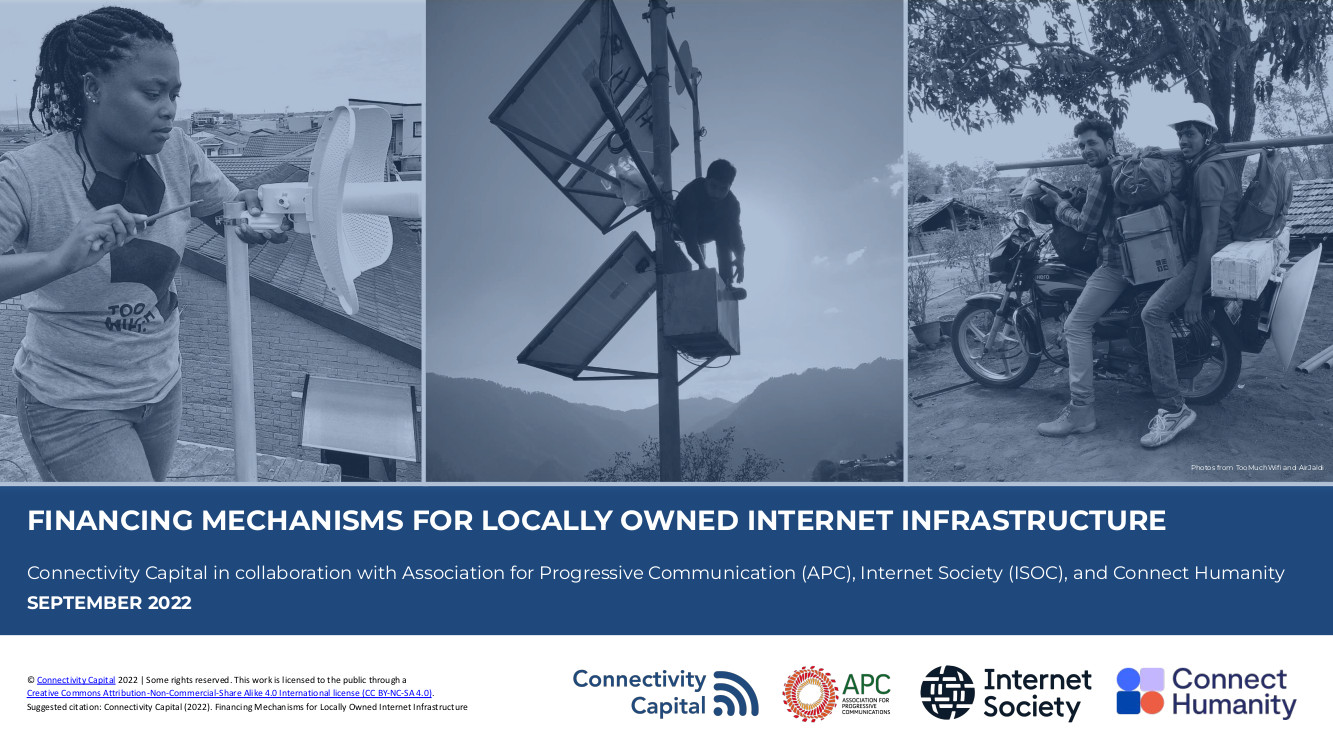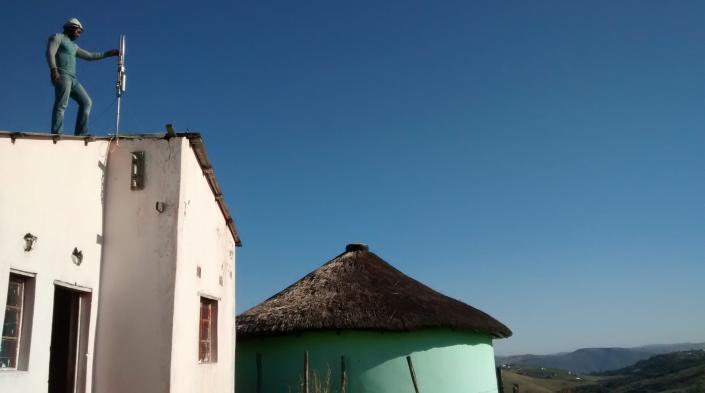
A new report featuring 11 case studies across 10 countries brings evidence that community-led initiatives are needed to bridge the digital divide. Discover why in this piece about the report’s launch and the inspiring experiences of two community networks, B4RN (UK) and Zenzeleni (South Africa), featured at the event.
“At the time, B4RN was faster than NASA.” This memorable statement was made by Chris Conder to an online audience while telling the story of the founding of Broadband for the Rural North (B4RN) — an award-winning non-profit community network set up in a rural farming area of Northern England in 2011. Since then, B4RN has deployed 5,000 km of fibre, connecting over 11,000 customers in a rural region where previously internet access was slow and unreliable, as pointed out by Ben Matranga, managing partner of Connectivity Capital, while introducing her at launch of the report, Financing Mechanisms for Locally-Owned Infrastructure, on 22 September 2022 (see the video below).
The inspiring experience shared by Conder during the event was one of the examples showing how community connectivity providers — such as community networks, municipal networks and social enterprises — are capable of offering great service at affordable costs and cover areas left behind by large, for-profit, incumbent telecommunications companies. Experiences like this are also proof that different models are needed to overcome the different barriers to bridge the digital divide. “It is simply not in the incumbent companies’ business model to invest in low-income communities, often rural and remote communities, that make up the majority of those still offline today,” explained Jochai Ben-Avie, co-founder and CEO of Connect Humanity.
And, even beyond, they demonstrate that digital inclusion can be done in ways that foster communities’ agency and to answer to their needs. Their journey, however, is not easy: the community initiatives cited, as many others, struggle to both access capital and find an enabling policy and regulatory environment, as the report concluded.

The report, Financing Mechanisms for Locally-Owned Internet Infrastructure, is the result of a partnership between Internet Society, Association for Progressive Communications, Connectivity Capital, and Connect Humanity, with support from UK Aid. This publication provides an overview of various network models, while examining how they can be financed sustainably to provide reliable and affordable internet to communities. Find out more here.
The report’s online launch brought together the following experts and builders to discuss strategies that can fund community-centred initiatives: Jochai Ben-Avie (Connect Humanity), Ben Matranga (Connectivity Capital), Jane Coffin (Connect Humanity), Bruce Patterson (EntryPoint Networks), Carlos Rey-Moreno (Association for Progressive Communications), Shaun Pather (Zenzeleni), Anoop Nagendra (Connectivity Capital), Chris Conder MBE (B4RN) and Juan Peirano (Internet Society).
Harnessing the strength of a community
To become a case study of success, B4RN faced many challenges. Originally, it was largely funded by individuals within the community who invested their own resources in the network through shares. It also relied on local champions to build a team. “Get community involved is the strength of a community network,” highlighted Conder. More recently, B4RN has harnessed millions of pounds worth of government vouchers and community investor loans, but it still has more than 2,900 shareholders who invest for a target return of 5% p.a., informs the report.
“There's nowhere else in the world that you can get what we deliver, gigabit symmetrical with all the backup and support that people get for £33 a month. It's just so good and so cheap. And the community ownership means … we are the company ourselves,” she pointed out.
Individual funding, however, was not an option for the residents of the remote village of Mankosi in South Africa’s East Cape, home to the country’s first community network. Zenzeleni, which means ‘do it yourself’ in isiXhosa, is helping provide connectivity in the region, where “affordable” has a different meaning: most of the population lives on below USD 1 a day. “It is a tension between having social objectives and providing affordable connectivity,”commented Shaun Pather, chairperson of the board of Zenzeleni Community Networks (Non-for-Profit).
Zenzeleni started in 2012 and was initially a local wireless intranet, providing free voice services to the village’s almost 6,000 residents. It added an external internet connection and grew into another successful community-owned internet service provider, currently made up of local community cooperatives working under an umbrella not-for-profit company.
Zenzeleni chose to be a non-profit for a number of reasons, according to Pather. It believed in the notion of not wanting to make a profit to reflect its community-based roots. But also, as a not-for-profit, it was able to get certain tax exemptions and present itself in a more appealing format to certain stakeholders along the way. Its model, however, may have also imposed some difficulties in attracting investors who do not want to invest in a not-for-profit.
“One of the early decisions that a network needs to make is regarding its ownership structure and operating model. And that choice has a major impact on the concentration of ownership, regulatory requirements, tax implications, operational complexity and ease of fundraising, among many other factors,” explained Carlos Rey-Moreno, co-lead of the community networks initiative from the Association for Progressive Communications (APC).

Photo: Zenzeleni Networks
To flourish, Zenzeleni has relied on various sources of funding, from private donors to civil society organisations, by executing a series of projects in different areas to foster digital skills, such as capacity-building. In terms of government support, it could access funding from the Department of Science and Innovation’s Technology Innovation Agency. But, all of these alternatives were designed for specific projects and activities and not to foster community-led solutions to the digital divide as a whole.
For non-profits, public support is key, but so far South Africa has not made the Universal Service Fund — created precisely to subsidise the promotion of universal access to telecommunications services — available to community-led models. “Regretfully, Zenzeleni, which in my view is most deserving of something like that, has not even seen a single cent of the Universal Service Fund, which would have put us in a very different place today in terms of our scale and growth,” explained Pather.
Despite this, Zenzeleni has survived to make a difference, and has a future ahead. “We've just conducted an independent evaluation with funding from Department of Science and Innovation, which provides empirical evidence that Zenzeleni has made a difference in the lives of the community itself,” Pather said, adding the organisation also advocates for a more supportive policy and regulation in the country.
Supporting communities, making change happen
Despite having different trajectories and building different models taking into consideration the local context, B4RN and Zenzeleni have many things in common. Both community networks faced multiple challenges to start and build their sustainability, but managed to rely on community resources to thrive while building new approaches to digital inclusion. Both focus on the needs of their communities rather than profit maximisation. And both faced initial challenges when it came to public support.
The report provided evidence that community connectivity providers can have distinct advantages. In fact, it demonstrated that they are better placed to offer better solutions in multiple cases, because going beyond addressing market failures in uncovered regions, they see their primary goal as sustainably meeting the digital needs of local residents. This means they work for digital equity taking into consideration not only access, but also affordability, adoption and local priorities.
Thus, one of the main recommendations in the report was creating an enabling regulatory environment to support these providers’ development and encouraging investment in community networks like B4RN, Zenzeleni and the other community-led initiatives, as highlighted by Juan Peirano, senior policy advisor on Internet Society. The recommendation “for policymakers, it is very clear and very obvious: try to enable these providers as much as possible,” he summarised.
The report also had recommendations for funders to unlock additional funding for community-led initiatives and for community connectivity providers, focusing on financial sustainability, suggestions to help communities prioritise cost-efficient deployments, identifying stage-appropriate sources of capital and diversifying revenue streams with a focus on self-reliance.
This content is based on the Financing Mechanisms for Locally-Owned Infrastructure report. You can find the report here.